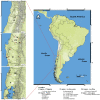Molecular survey of tick-borne infectious agents in cricetid rodents (Rodentia: Cricetidae) in Central and Southern Chile
- PMID: 38828369
- PMCID: PMC11141396
- DOI: 10.3389/fvets.2024.1399783
Molecular survey of tick-borne infectious agents in cricetid rodents (Rodentia: Cricetidae) in Central and Southern Chile
Abstract
Tick-borne infectious agents (TBIAs) include several bacteria and protozoa that can infect vertebrates, including humans. Some of these agents can cause important diseases from both a public health perspective, such as Lyme disease, and from an animal health and production viewpoint, such as Texas fever. In Chile, several studies have assessed the presence of tick-borne disease agents in vectors and mammal hosts, mainly in the northern regions, but few studies have assessed the presence of these agents in Central and Southern Chile. This study aimed to assess the presence of three groups of TBIAs-Borrelia, Anaplasmataceae, and Piroplasmida-in cricetid rodents of Central and Southern Chile. A total of 207 specimens from 13 localities between the O'Higgins and Los Lagos regions were captured. DNA was extracted from the liver and spleen, and subsequently underwent polymerase chain reaction (PCR) amplification targeting the 16S rRNA, flaB, and 18S rRNA genes to detect DNA from Borrelia, Anaplasmataceae, and Piroplasmida, respectively. Although no DNA from these TBIAs was detected, the DNA extraction process was validated by optimal DNA purity ratios (an A260/A280 ratio within the 1.6-2.0 range) and successful internal control amplification in all samples. These results, in addition to findings from previous reports, suggest a very low prevalence of these TBIAs in the rodent population studied. Further research into the factors influencing the presence of these agents and their vectors will provide insight into the reasons underlying this low prevalence.
Keywords: South American rodents; genetic screenings; surveillance; tick-borne disease; wild rodents.
Copyright © 2024 Ardila, Thomas, Santodomingo, Silva-de la Fuente, Muñoz-Leal, Landaeta-Aqueveque and Henríquez.
Conflict of interest statement
The authors declare that the research was conducted in the absence of any commercial or financial relationships that could be construed as a potential conflict of interest.
Figures

Similar articles
-
Molecular Survey of Rodent-Borne Infectious Agents in the Ferlo Region, Senegal.Genes (Basel). 2023 May 18;14(5):1107. doi: 10.3390/genes14051107. Genes (Basel). 2023. PMID: 37239466 Free PMC article.
-
Rodents as potential reservoirs for Borrelia spp. in northern Chile.Rev Bras Parasitol Vet. 2020 Jun 26;29(2):e000120. doi: 10.1590/S1984-29612020029. eCollection 2020. Rev Bras Parasitol Vet. 2020. PMID: 32609236
-
Survey and Molecular Characterization of Sarcocystidae protozoa in Wild Cricetid Rodents from Central and Southern Chile.Animals (Basel). 2023 Jun 24;13(13):2100. doi: 10.3390/ani13132100. Animals (Basel). 2023. PMID: 37443898 Free PMC article.
-
Update on Tick-Borne Bacterial Diseases in Travelers.Curr Infect Dis Rep. 2018 May 22;20(7):17. doi: 10.1007/s11908-018-0624-y. Curr Infect Dis Rep. 2018. PMID: 29789953 Review.
-
[Tick borne zoonosis: selected clinical and diagnostic aspects].Parassitologia. 2004 Jun;46(1-2):109-13. Parassitologia. 2004. PMID: 15305697 Review. Italian.
References
-
- Ceballos G, Simonetti J. Diversidad Y Conservación De Los Mamíferos Neotropicales: Comisión Nacional para el Conocimiento y Uso de la Biodiversidad Mexico. Comisión Nacional para el Conocimiento y Uso de la Biodiversidad, CONABIO. Universidad Nacional Autónoma de México. Instituto de Ecología (2002).
-
- D’Elía G, Canto J, Ossa G, Verde-Arregoitia LD, Bostelmann E, Iriarte A, et al. . Lista Actualizada De Los Mamíferos Vivientes De Chile. Boletín Museo Nacional Hist Nat. (2020) 69:67–98. doi: 10.54830/bmnhn.v69.n2.2020.6 - DOI
-
- Muñoz-Pedreros A, Gil C. Orden Rodentia In: Muñoz-Pedreros A, Yáñez J, editors. Mamíferos De Chile. 2nd ed. Valdivia: Editorial CEA; (2009). 93–157.
-
- Palma RE. Estado Actual De La Mastozoología En Chile. Mastozool Neotrop. (2007) 14:5–9.
LinkOut - more resources
Full Text Sources

